Sialadenitis is the inflammation of the salivary glands, the glands that produce saliva in our mouths. Saliva is essential for the normal functioning and health of the mouth. Â Disorder of salivary glands function can lead to oral disease, for example tooth decay and gum disease. Sialadenitis is usually caused by bacterial or viral infection but the disorder can occasionally be due to other causes, such as trauma, radiation and allergic reactions.
Bacterial sialadenitis
Bacterial sialadenitis can be generally divided into acute and chronic forms.
Acute bacterial sialadenitis
This uncommon disorder mainly involves the parotid gland.
Causes of parotid sialadenitis
The main bacteria involved are Streptococcus pyogenes and Staphyloccus aureus, and they infect the salivary gland by ascending the ductal system due to reduced salivary flow associated with:
- Dehydration, for example following abdominal surgery
- Radiotherapy for oral or salivary gland cancer
- Gland or duct abnormalities or obstruction
- Sjögren syndrome
- Weaken immune system
- Result of aggravation in a previously chronic sialadenitis, usually seen in submandibular sialadenitis
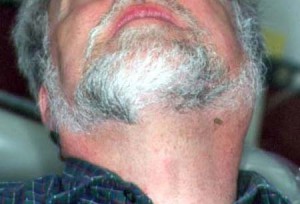
Acute bacterial sialadenitis of left parotid gland © BMJ Publishing Group

Acute bacterial sialadenitis of left parotid gland © BMJ Publishing Group
Parotid sialadenitis symptoms
Acute parotitis presents with:
- Painful swollen salivary gland
- Redness of the overlying skin
- Pus may exude from the parotid duct
- Difficulty in opening the mouth
- Fever
- Swelling of the lymph nodes in the neck region
- Body discomfort
Acute bacterial sialadenitis treatment
The pus collected from the salivary duct will be taken for laboratory testing and antibiotics will be prescribed to you by your dentist or doctor. Any soft swelling should be surgically drained and supportive therapy, such as adequate fluid intake, painkillers and practice of good oral hygiene, is important. Once the acute condition has resolved, the causative factors, such as duct stones, are to be identified and corrected.
Chronic bacterial sialadenitis
Causes of chronic sialadenitis
Mainly involving the submandibular gland, this disease that reduces the salivary flow is:
- Most often due to obstruction of the salivary duct by duct stones (salivary calculi)
- Low-grade ascending infection
- This may also develop following acute sialadenitis, particularly if the acute condition was not treated adequately or causative factors not removed.
Chronic sialadenitis symptoms
- Swelling on one side of the face
- Can be symptomless or with intermittent pain of the gland
Chronic sialadenitis treatment
Treatment can vary depending on the position of the duct stone. If the stone is within the duct, the stone can be removed with the duct but if the stone is within the gland, the entire gland will have to surgically removed.
Viral sialadenitis
Mumps (acute viral sialadenitis, epidemic parotitis)
A common acute viral disease that mainly affects the parotid glands, mumps is highly infectious and is the most common cause of acute parotid swelling.
Cause of mumps
Mumps is caused by:
- An paramyxovirus (mumps virus)
- Transmitted by direct contact or by droplets of saliva
- Long dormant period of 2 to 3 weeks
- Followed by immunity to further attacks
Mumps symptoms
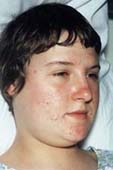
© Family Of The Child
Children are mainly affected. Typically:
- Painful swelling (parotitis), usually on both sides of the face
- Difficulty in opening the mouth
- Fever
- Headache
- Body discomfort
Mumps in adults is less common but once infected, it may involve other organs:
- Orchitis (Inflammation of one or both testes)
- Pancreatitis (Inflammation of the pancreas)
- Meningoencephalitis (Inflammation of the brain and spinal cord and their meninges)
- Rarely, oophoritis (Inflammation of one or both ovaries)
Mumps treatment
No specific anti-viral agents are available therefore treatment is symptomatic involving:
- Painkillers
- Adequate hydration
- Reducing fever
- Infected individuals are advised to isolated themselves for 6 to 10 days since virus is in saliva during this time
Mumps will resolve by itself after about 7 days.
Prevention of mumps
Mumps vaccination is provided as the measles-mumps-rubella (MMR) vaccination. The vaccination is given at around 1 to 4 years of age.
Postirradiation sialadenitis
Radiation sialadenitis is a common complication of radiotherapy directly related to the dose of radiation given. Infection in severely damaged salivary glands is often irreversible but with less damage, some degree of salivary gland function may return after several months.
Obstructive sialadenitis (sialolithiasis)
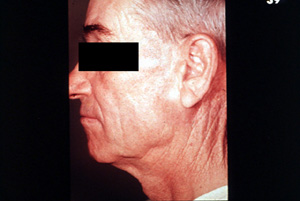
Benign parotid tumor
Salivary duct obstruction is not uncommon and is usually caused by:
- A calculus (stone) (mostly in submandibular glands)
- Spasm or an abnormal passage of the parotid duct
- Mucus plug (mostly in parotid glands)
- Tumor
- Abnormal narrowing of the duct
- Rarely from irritation of the duct by, for example a denture clasp
Sialolithiasis symptoms
Duct obstruction can cause:
- Painful swelling of the gland
- Pain just before or at mealtimes due to disruption of salivary flow
- There may be dull pain over the affected gland in older patients
Sialolithiasis treatment
X-rays, sialography, CT, MRI or ultrasonography are taken to determine the position of the stone. Duct obstructions are usually correctable by removing the cause.
When to see a doctor
Contact your doctor when you develop any of the following symptoms:
- Painful swelling on the face especially over the salivary glands
- Difficulty in opening your mouth
- Dry mouth
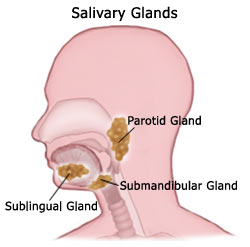
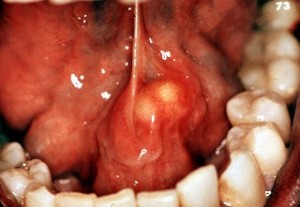
Pingback: How to Prevent Salivary Gland Cancer | Intelligent Dental
Pingback: Sjogren's Syndrome | Intelligent Dental
Pingback: How does dry mouth causes fatigue | Intelligent Dental
Pingback: Infectious Mononucleosis: The Kissing Disease | Intelligent Dental